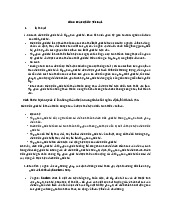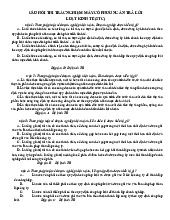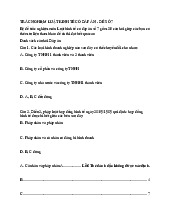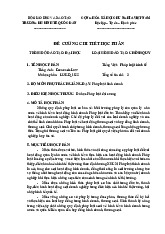







Preview text:
lOMoARcPSD| 38777299
CHAPTER 9: NEGATIVE MESSAGES
Exercise I: Match these terms with their definitions. (10 questions)
1. Goodwill a friendly, helpful and cooperative feeling or attitude
2. Morable the confidence, enthusiasm, and discipline of a person or group at a particular time
3. Buffer a neutral or positive opening that reduces shock or pain and does not reveal the negative news.
4. Restitution apology to a customer that involves explaining concretely what you will do to make things right
5. Slander the term referring to the abusive language which is spoken
6. Libel the term referring to the abusive language which is written
7. Defamation the legal term for any false statement, written or spoken, that harms an individual's reputation
8. Empathy the ability to understand and enter the feelings of another and is important to convey in negative messages
9. Actionable the term referring to abusive language that may result in a lawsuit
10. Remorse apology to a customer that involves a feeling of guilt and regret about something you have done
Exercise II: Are the following statements true or false? Correct the false statements. (10 questions)
1. The bad feelings associated with disappointing news can generally be reduced if the
receiver knows the reasons for the rejection. TRUE
2. A goal in conveying unfavorable news in writing should be to make the receiver call or
write back to clarify the message; this way, the writer has a chance to explain further. FALSE
A goal in conveying unfavorable news in writing should not be to make the receiver call or
write back to clarify the message.
Recipients of negative news should be able to understand the message clearly without
having to call or write for clarification.)
3. When you have negative news to deliver, one of your first considerations is how the
message will affect its receiver. TRUE
4. When you work for an organization, your words, decisions, and opinions are assumed to
represent legally those of the organization. TRUE
5. Because bad news can be difficult for a reader to accept, it should always be delivered
using the indirect method. FALSE
Many bad-news letters are best organized indirectly, beginning with a buffer and reasons.
However, the direct pattern, with the bad news first, may be more effective when the bad
news is not damaging, when the receiver may overlook the bad news, when the organization or receiver prefers directness, or when firmness is necessary.
6. Company policy does not allow us to give cash refunds effectively explains why a writer's
request must be refused. FALSE
Instead of making a blanket policy statement, which many readers resent, explain your
company policy so that the reader will understand why such a policy makes sense. lOMoARcPSD| 38777299
7. A good technique for de-emphasizing negative news is to place it at the end of a paragraph. FALSE
An effective technique for de-emphasizing negative news is to put it between other sentences
in the middle of a paragraph. Placing it at the beginning or end of a paragraph will emphasize it.
8. Because we value loyal customers like you, we have enclosed a coupon for $20 for your
next meal at The Cheesecake Factory is an effective closing statement for a negativenews message. TRUE
9. Online customer complaint sites are losing momentum because customers no longer feel
that they are heard. TRUE
10. Communication is unethical when the sender has the intent to deceive. TRUE
Exercise III: Complete the following sentences with a suitable word or phrase (10 questions)
1. In asking yourself if your message is too blunt or too subtle, you are evaluating the message.
2. The key to ethical communication lies in the motives of the sender.
3. When the bad news is not damaging, when the reader may overlook the bad news, or
when firmness is necessary, the direct organizational pattern should be used.
4. Business communicators should use the indirect organizational pattern to deliver bad
news when the news will be personally upsetting, will provoke a hostile reaction, will
threaten the customer relationship, or is unexpected.
5. Without a sound explanation of the reasons for denying a request, refusing a claim, or
revealing other bad news, a message will fail, no matter how cleverly it is organized or written.
6. One useful technique for reducing the pain associated with a negative-news message is to
place the refusal in a(n) subordinate dependent clause.
7. One way to soften negative news in a message is by suggesting a compromise or
alternative to the receiver, such as suggesting that a loan applicant return with a cosigner to reapply.
8. Closing a bad-news message with a statement such as Visit our website soon for our
summer concert schedule uses resale information or sales promotion to encourage the
customer's continued patronage.
9. To avoid charges of discrimination or wrongful actions, legal advisors urge organizations
to keep employment rejection letters general, simple, and short.
10. Passive-voice verbs are effective in many bad-news messages because they enable you to
highlight the action rather than focusing attention on a person.
Exercise IV: Circle the best answer. (15 questions)
1. The bad feelings associated with disappointing news can generally be reduced if the receiver ________. A.
believes that the matter was treated seriously and fairly B.
feels the news was revealed sensitively C. knows the reasons for the rejection D.
All of these choices apply.
2. Goals in communicating negative news should include helping the receiver understand
the news, showing your desire to continue pleasant relations with the receiver, and ________. lOMoARcPSD| 38777299
A. buffering the negative news in all situations
B. ceasing communication with the receiver
C. hiding the real reason for the negative news
D. maintaining a professional and positive image of you and your corporation
3. Victoria had to write a letter to a job applicant telling him that he was not selected for a
position. Because she really liked the applicant, she wrote in the rejection letter, "I
thought you were our top candidate." What has Victoria done that might lead to legal difficulties?
A. She is guilty of the "good-guy syndrome."
B. She has used careless language.
C. She has used abusive language.
D. She has done nothing wrong.
4. The major differences between the direct and indirect strategies are whether you start with a buffer and ________.
A. whether you apologize
B. whether you address the reader by name
C. whether you accept blame for the bad news
D. how early you explain the reasons for the negative news
5. Cassandra will be writing a bad-news letter to a customer and wants to follow the
fourpart indirect plan. In what order should she organize her letter?
A. Bad news, reasons, buffer, closing
B. Buffer, reasons, bad news, closing
C. Buffer, bad news, reasons, closing
D. Reasons, bad news, buffer, closing
6. What is the most accurate statement about keeping the indirect strategy ethical?
A. The indirect organizational strategy is unethical and manipulative because the writer
deliberately delays the main idea.
B. When you use the indirect strategy, your motives are to deceive the reader and to hide the news.
C. By delaying bad news, you soften the blow somewhat, as well as ensure that your
reasoning will be read while the receiver is still receptive.
D. Because the indirect strategy provides a setting in which to announce bad news, it
should be used to avoid the truth.
7. Wesley has included this opening statement in a bad-news message to a client: We both
realize that the current economic downturn has resulted in lower stock prices. What kind of buffer is this? A. Compliment B. Agreement C. Appreciation D. Best news
8. The most important part of a bad-news letter is ________.
A. a good buffer that starts the letter positively
B. the professional letterhead on which it is printed
C. a closing that ends the letter on a positive note
D. the section that explains the reasons for the bad news
9. In which of the following sentences has the bad news been placed in a subordinate clause? lOMoARcPSD| 38777299
A. Although our wellness program must be discontinued, all other benefits will remain
the same.
B. Although all other benefits will remain the same, we must discontinue our wellness program.
C. Our wellness program must be discontinued.
D. We are sorry to announce that our wellness program must be discontinued.
10. Which of the following sentences most effectively implies the refusal?
A. I'm sorry that I won't be able to speak at your annual conference, but I'd like to be
considered in future years.
B. Although I'll be in Southeast Asia on business on the date of your annual conference,
I could speak to members prior to that date.
C. Although I am unavailable to speak at your annual conference, I can recommend another speaker.
D. Thank you for your kind invitation to speak at this year's annual conference.
11. Which of the following would be the most effective statement in a letter refusing a local
organization’s request for a charitable donation?
A. Even though our budget won't allow a contribution this year, we hope to be able to
contribute next year.
B. Please accept our sincerest apologies for being unable to donate to your cause.
C. We are unable to contribute this year because of budget constraints.
D. Unfortunately, company policy prevents us from donating to your cause.
12. What statement about delivering bad news within an organization is most accurate? A.
Bad news within organizations should always be delivered in writing.
B. Generally, bad news within organizations is better received when the reasons are given after the bad news.
C. A tactful tone is useful when communicating bad news within organizations.
D. Bad news within organizations should always be delivered using the direct organizational pattern.
13. Jeannie must deliver bad news to her staff in person, and she knows they’ll be upset.
What should Jeannie do first to prepare for the meeting?
A. Practice what she will say during the meeting.
B. Call each staff member to give them fair warning that bad news is coming.
C. Gather all relevant information.
D. Share the news with selected staff members to see how they feel.
14. Select the best subject line for a memo delivering bad news to employees.
A. Discontinuation of Free Parking
B. Change in Parking Benefit C. Parking
D. Major Reduction in Parking Privileges
15. When writing a letter to a customer denying credit, you should have four goals. Which of
the following is not one of these goals?
A. Promising the customer that credit will be granted in the future
B. Retaining the customer on a cash basis
C. Avoiding language that causes hard feelings
D. Avoiding disclosures that could cause a lawsuit
EXERCISE V: CLASSIFY THE FOLLOWING ITEMS INTO FOUR GROUPS A/B/C/D
(4-5 groups; 15-20 items) lOMoARcPSD| 38777299 Groups A.
Techniques to apologize effectively 1,7,13,15,16 B.
Techniques to cushion the bad news 3,4,5,11,12 C.
Techniques to convey negative news without incurring legal liability 2,6,8 D.
Techniques to buffer 9,10,14,17 List of items
1. Say it won’t happen again and mean it (repeating) 2. Remove careless language 3. Imply the refusal 4. Use the passive voice 5. Highlight the positive 6. Avoid abusive language
7. Embrace I apologize & I am sorry sincerely and honestly(remorse)
8. Avoid the Good – Guy Syndrome 9. Give compliment 10. Deliver best news
11. Suggest a compromise of an alternative
12. Position the bad news strategically
13. Acknowledge the specific offense (recognition)
14. Show agreement, appreciation, or understanding
15. Explain exactly how you will fix a problem (Restitution)
16. Accept responsibility (responsibility) 17. Provide facts
EXERCISE VI: Revise the following sentences to correct word usage errors. Sentences may
have more than one error. If a sentence is correct, write C. Are there any confusing words
and frequently misspelled words?
Example: Have you allready sent the reccomendation? Revision:
Have you already sent the recommendation?
1. Good listeners absorb facts rather then interupting with frequent questions. => Good
listeners absorb facts rather than interrupting with frequent questions.
2. Her principle reason for declining the invitation was her busy calander.
=> Her principal reason for declining the invitation was her busy calendar.
3. The manager was conscience of the navigation problems at the company Web sight. => The
manager was conscience of the navigation problems at the company website.
4. Because Nedra felt overwhelmed by the every day demands of her job, she sought advise from her mentor.
=> Because Nedra felt overwhelmed by the everyday demands of her job, she sought advice from her mentor.
5. Before you procede with the report, check those embarassing statistics. lOMoARcPSD| 38777299
=> Before you proceed with the report, check those embarrassing statistics
6. Although we should look into this matter farther, I am not suprised at your report.
=> Although we should look into this matter farther, I am not surprised at your report.
7. The judge declared that the comments of there attorneys were irrevelant to the case at hand.
=> The judge declared that the comments of their attorneys were irrelevant to the case at hand.
8. Because the property was to difficult to apprise, its value was unrecorded. => Because the
property was too difficult to apprise, its value was unrecorded 9. Jordan hoped to illicit advice
from his counselor, but he was disapointed.
=> Jordan hoped to illicit advice from his counselor, but he was
disappointed 10. Is it neccessary to complement fellow team members when
they excel => Is it necessary to complement fellow team members when they excel.
EXERCISE VII: Analyze this situation and answer the questions that follow.
Based on what you have learned in this chapter on how to write a negative message, describe
several broad principles that could be applied in helping the individual writing the message below understand what went wrong.
Discuss: What are the specific weaknesses in the message? Current date Ms. Sheila Trumbo, Owner Royal Oak Realty, Inc. 743 South Washington Royal Oak, MI 48067 Dear Ms. Trumbo:
We regret to inform you that we cannot allow you to convert the payments you have been
making on your Canon X1000 color copier toward its purchase, much as we would love to do
so. We understand that you have been making regular payments for the past 16 months. Our
established company policy prohibits such conversion of leasing monies. Perhaps you have
noticed that we offer extremely low leasing and purchase prices. Obviously, these low prices
would never be possible if we agreed to many proposals such as yours. Because we are striving
to stay in business, we cannot agree to your request asking us to convert all 14 months of rental
payments toward the purchase of our popular new equipment.
It is our understanding, Ms. Trumbo, that you have had the Canon X1000 color copier for 16
months, and you claim that it has been reliable and versatile. We would like to tell you about
another Canon model—one that is perhaps closer to your limited budget. Sincerely,
a. Fails to develop a positive tone with a gracious opening and closing.
b. Instead of opening bluntly, the writer should have started with positive remarks about the
regular payments the customer has made in 16 months. lOMoARcPSD| 38777299
c. Emphasizes the refusal instead of softening it throughout and suggesting an alternate benefit.
d. Could have softened the bad news by implying it or by inserting it into a subordinating clause followed by a benefit.
e. Closes with a negative statement instead of emphasizing a benefit and looking forward positively (resale)
f. Using words that sound unprofessional or careless: extremely low; your limited budget.
g. Blanket policy statement (our company policy prohibits) Specific weaknesses: long
lead-ins: I am writing this message because,
fillers & redundancies: There were several points of an important nature that are….; As
a last and final point; elaborate and expand on; Empty words: an important nature
wordy compound prepositions: were several points of an important nature verbs
converted to nouns (buried verbs): should give consideration; as an encouragement to
people; make an illustration of it.
trite expressions: pursuant to your request general wordiness.
Lack of bullet points and category headings to improve readability
EXERCISE VII. Identify errors & revise messages
1. Despite the fact that we lost one of the most important account, we must at this
point in time focus on improving customer service. 2
Fails to develop a positive tone with a gracious opening and closing.
b. Instead of opening bluntly, the writer should have started with positive remarks about the
regular payments the customer has made in 16 months
c. Emphasizes the refusal instead of softening it throughout and suggesting an alternate benefit.
d. Could have softened the bad news by implying it or by inserting it into a subordinating clause followed by a benefit.
e. Closes with a negative statement instead of emphasizing a benefit and looking forward positively (resale)
f. Using words that sound unprofessional or careless: extremely low; your limited budget
g. Blanket policy statement (our company policy prohibits)
EXERCISE VIII: Revise messages (the whole messages) based on the identification of its
weakness in exercise vii. Current date Ms. Sheila Trumbo, Owner Royal Oak Realty, Inc. 743 South Washington Royal Oak, MI 48067 Dear Ms. Trumbo:
We regret to inform you that we cannot allow you to convert the payments you have been
making on your Canon X1000 color copier toward its purchase, much as we would love to do so.
We understand that you have been making regular payments for the past 16 months.
Our established company policy prohibits such conversion of leasing monies. Perhaps you have
noticed that we offer extremely low leasing and purchase prices. Obviously, these low prices
would never be possible if we agreed to many proposals such as yours. Because we are striving lOMoARcPSD| 38777299
to stay in business, we cannot agree to your request asking us to convert all 14 months of rental
payments toward the purchase of our popular new equipment.
It is our understanding, Ms. Trumbo, that you have had the Canon X1000 color copier for
16 months, and you claim that it has been reliable and versatile. We would like to tell you
about another Canon model—one that is perhaps closer to your limited budget. Sincerely, => Current date Ms. Sheila Trumbo, Owner Royal Oak Realty, Inc. 743 South Washington Royal Oak, MI 48067 Dear Ms. Trumbo:
We understand that you have been making regular payments for the past 16 months on your
Canon X1000 color copier toward its purchase. You have chosen our best – selling model and
there is no surprise that you also find this device reliable and versatile.
Perhaps you have noticed that we offer reasonably leasing and purchase prices and customers
have benefited financially from this policy. Obviously, all the leases have a buyout clause, or an
end-of-lease purchase option and you agreed to all the terms in our contract. These low prices
would never be possible if customers changed their mindhalf way through it.
Although conversion of leasing money is not applicable for such contract, we appreciate that you
trust Cannon products and would like to convert all 14 months of rental payments toward the
purchase of our popular new equipment.
We would like to tell you about another Canon model, Canon SX 1000—one that perhaps is
closer to your budget. Please visit our website to see updated products on our online catalogue or
call 301 – 746 – 882 to arrange a date to experience this new model. We would be happy to give
you a free inspection and consultation on that new model. Sincerely,




